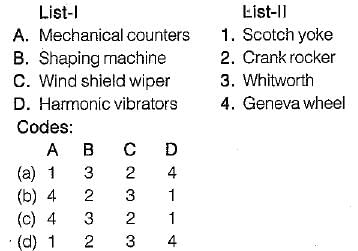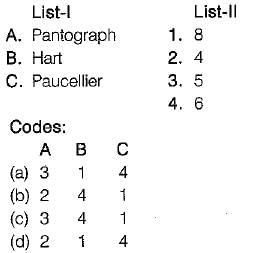Test: Mechanism With Lower Pairs - 1 - Mechanical Engineering MCQ
10 Questions MCQ Test Topicwise Question Bank for Mechanical Engineering - Test: Mechanism With Lower Pairs - 1
Match List-I (Application) with List-II (Mechanism) and select the correct answer using the codes given below the lists:


Match the List-I (Mechanism) with List-ll (Number of links):


Which of these mechanisms gives an approximately straight line?
Which of the following mechanism is extensively used as a substitute for T-square and set- square?
The Davis steering gear fullfills the condition of correct gearing at
The Ackermann steering gear fulfills the condition of correct gearing at
The ratio between the width of the front axle and that of the wheel base of a steering mechanism is 0.44. At the instant when the front inner wheel is turned by 18°, what should be the angle turned by the outer front wheel for perfect steering?
[Take cot18° = 3.078, cot16° = 3.487, cot20° = 2.747]
In automobiles, Hook’s joint is used between which of the followings?
|
45 videos|314 tests
|























